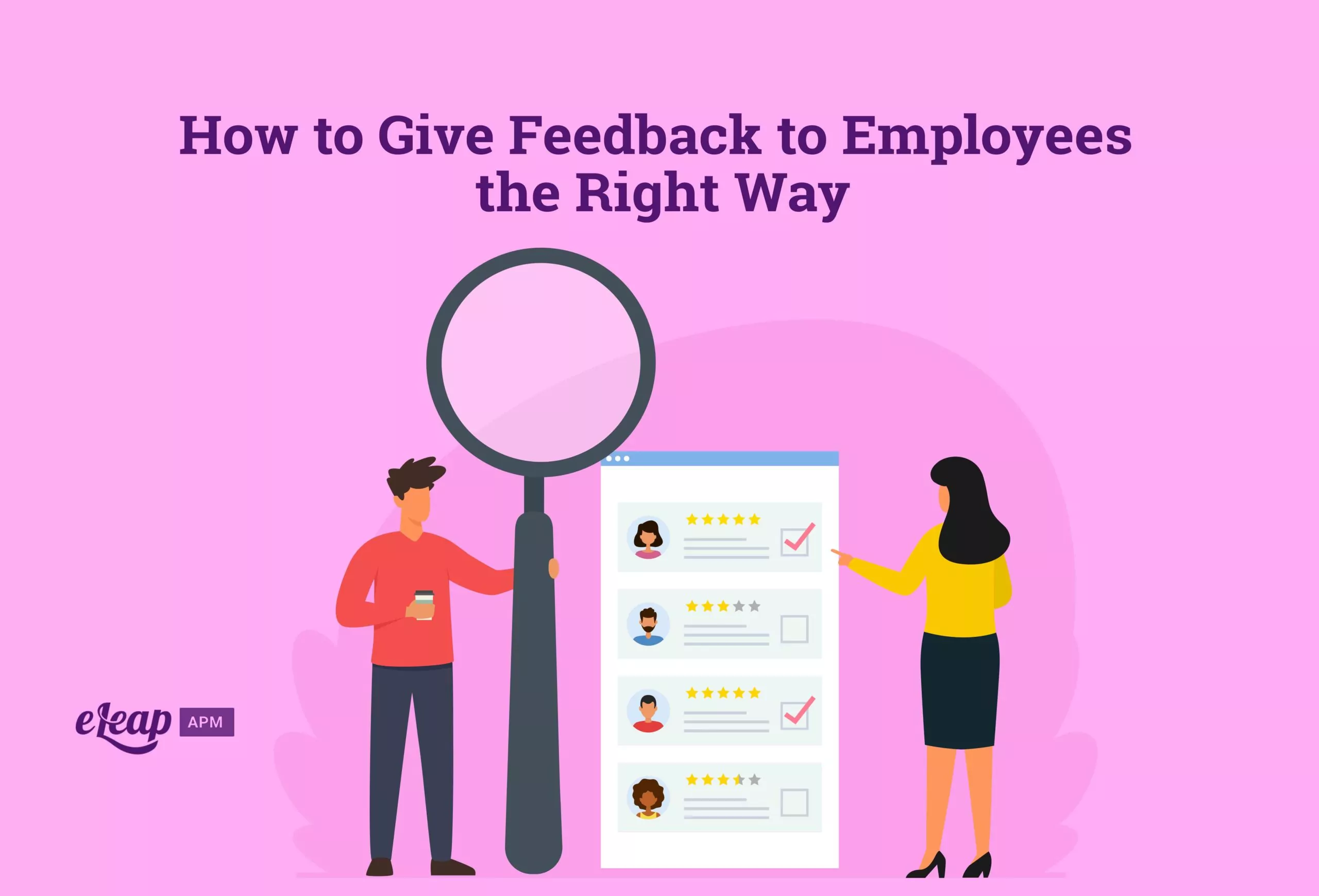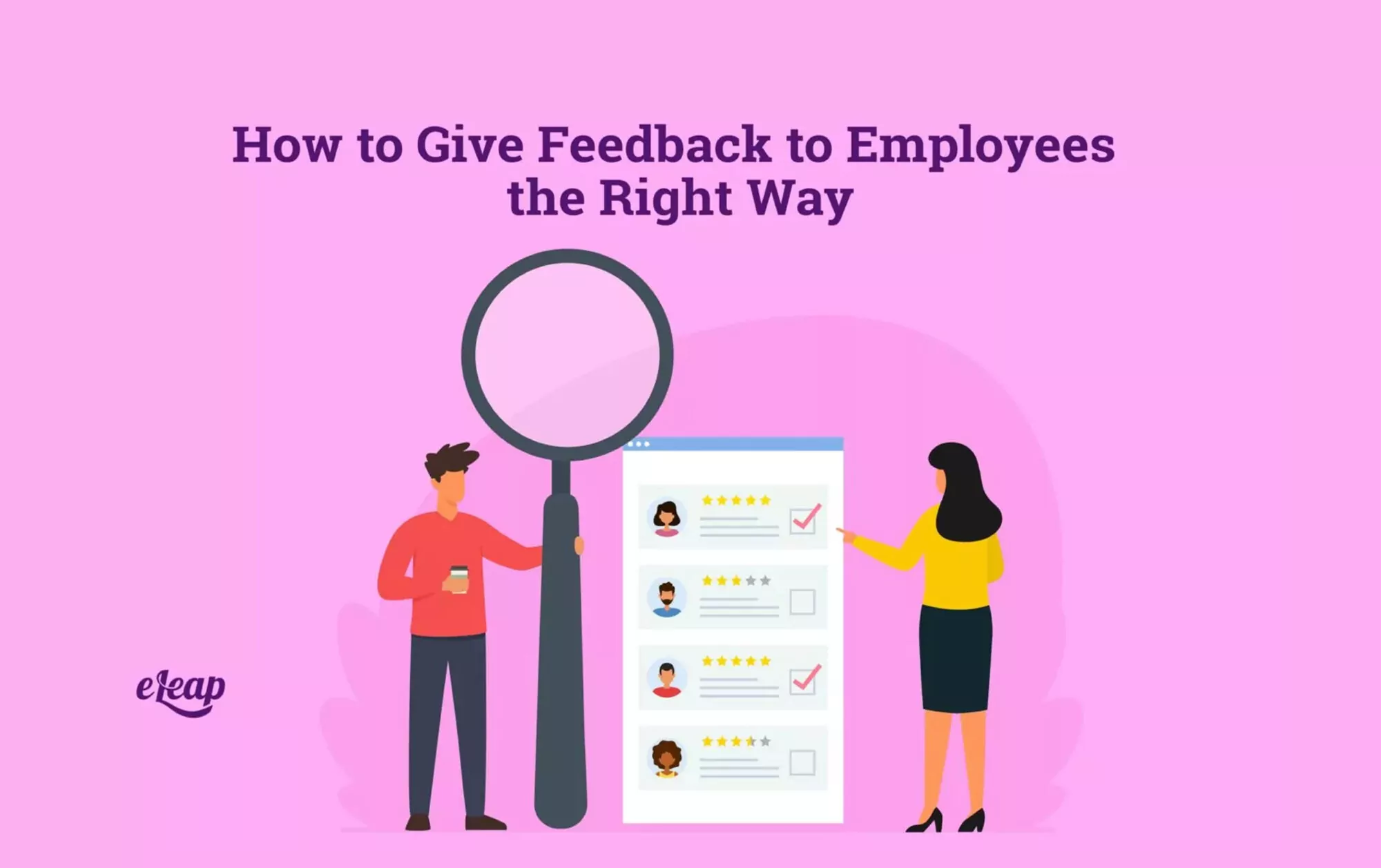How to Give Feedback to Employees the Right Way

When you learn how to give feedback to employees, you are helping them to grow and become better employees, and hopefully happier employees. Of course, you do need to be sure you are providing feedback correctly. If you don’t approach your employees the right way, the feedback isn’t going to help them or your business. When used properly, employee feedback can be a powerful means of helping your team grow and develop. Naturally, this has the potential to benefit your entire organization. Explore how eLeaP’s Performance Management Platform can simplify evaluations, boost productivity, and drive measurable results.
Unfortunately, not all companies put much stock in feedback for one reason or another. Some ignore it entirely either because they feel it will take too long to do regularly or because they don’t like the feelings of discomfort that can often creep up when managers have to talk with their employees about an issue.
When feedback is neglected, though, the entire organization will end up suffering. Your employees will not learn and grow and may never even realize the things they’ve been doing wrong. Your company won’t benefit from having engaged employees who are working to improve the workplace.

Tips on How to Give Feedback to Employees
We can make things easier for you, though, when you follow the tips that we discuss below. These can help managers like you learn the best ways of how to give feedback to employees.
No Unsolicited Advice
When feedback is unsolicited, it often goes unheeded. People who aren’t accustomed to feedback might just think the manager is complaining just to complain, and they might not realize how serious it can be. It is always a good idea for you to introduce the concept of having a feedback loop in the workplace as early as possible. Everyone on your team needs to understand how feedback will be implemented and why it is important.
While you should strive to set up regular employee feedback sessions with your team, you should also allow your employees to come to you and request feedback. They could be tackling a new project, for example, and they might want some help and guidance along the way via feedback from a manager.
Feedback Should Be Clear
Here is where a lot of managers have problems. They may know that there is a problem, but they do not always know the best way to talk about it with the employee. It is vital that you are as specific as can be when you are offering feedback. If you are vague, the employee will not know how to correct their problem.
What you want to do is be specific and provide some guidance on how to make changes. You don’t need to necessarily solve the problem for them. Instead, you can work on coming up with a solution together. This is also going to give them more agency.
Remember the Importance of Empathy
You have probably been on the receiving end of more than one performance review in your life. How did you feel going into those reviews? If you were working for a good company that cared about your development and well-being, and you were confident in your role, you might’ve not had any worries. However, there’s a good chance that even if you are a model employee, you still get a bit nervous when you are in these situations. It’s natural, and that’s something you need to keep in mind.
Your employees are worried whenever it comes time for feedback because they fear they might be in trouble. They worry about their job, the potential for a raise, mistakes they’ve made, etc.
Always be as empathetic as possible when you are giving feedback and reviews. It doesn’t mean you should ever shy away from giving bad news when it’s required, of course. It just means that you need to remember how your employees are feeling.
Don’t Put Off Feedback to Employees for Quarterly Reviews
Providing employee feedback as soon after an event—positive or negative—as possible is the best option. You don’t want to wait too long to provide feedback because it is too easy to forget things. This means that certain issues might not be addressed right away or at all. Those problems are then much more likely to persist. If you let issues add up, they tend to cause bigger and bigger problems at the company, and that’s the last thing you need.
Ideally, you will get into a feedback rhythm in the workplace and provide regular reviews. This way, anything that comes up in a quarterly or annual performance review doesn’t come as a shock to the employee.
Share Positive Feedback
One of the other areas where some managers have problems is that they only focus on negative feedback. While you don’t want to use the sandwich method of good news/bad news/good news, you do want to celebrate some of the wins that the individual has. Share positive feedback with the employees but do it at a different time than when you are giving them bad feedback.
Giving the employees some good feedback will help to give them more confidence and let them know the things they are doing right.
The Feedback Needs to Be Private
No one wants to be singled out and criticized in public, even if it is just in front of one or two of their coworkers. You should have a private location, such as an office or conference room where the meetings can be held. Another option might be to provide feedback in writing. While this might be preferred by some employees, others may feel that it lacks a personal touch.
Something else you want to keep in mind is that even positive feedback might be better in private for some employees. There may be those who are socially anxious and who don’t want to be the center of attention. In those cases, you will want to provide praise in private, as well. Of course, most people will be happy if you were to sing their praises in front of the entire office.
Be Willing to Receive Feedback
Managers shouldn’t only dish out feedback. They should also make it a point to tell the employees that they want to receive feedback. The conversation should go both ways, so managers better understand ways that they can improve in their roles.
Top Reasons You Need to Give Feedback to Employees
Why do you need to provide your employees with feedback? How else are they going to know how they are doing in their job? If you aren’t providing them with regular feedback, they will not know if they are making mistakes for starters. Below, we will be looking at the best reasons to start providing regular feedback.
Better Performance
You want your employees to shine and to do well, and you want them to be happy. You want their performance to be up to snuff and feedback is an important part of making that happen. Managers who regularly provide feedback and who receive feedback from their employees will find that these individuals become more productive.
They feel more engaged with your company and with the work they are doing. The employees feel that you care about how things are going for them and that you want what’s best. It can increase their level of commitment, particularly when they receive the training and guidance they need to succeed. They feel that your company is willing to invest in them.
Reduce Conflicts
Feedback should be commonplace in the company. When they are part of the company culture, feedback tools tend to provide employees with the tools they need for issues and conflicts that might occur. It is important to deal with them before they get out of hand. These tools provide an outlet to talk about problems, and when feedback is normalized at work, it reduces the stigma that often comes with trying to have difficult conversations.
Increased Employee Engagement
Engagement and feedback are tied together. Feedback allows issues with employees and managers to be resolved, which is great. However, it will do more than this. You will find that it also helps to provide personal feedback and a way to celebrate victories. When feedback is encouraged, employees see that the company values them and wants them to improve. Naturally, they are going to then feel more engaged with the company and want to do well in the organization.
How Often Should You Give Feedback to Employees?
The answer to this question is going to vary. You will find that a lot of experts feel you should strive to have team leaders provide some sort of employee feedback weekly or biweekly. This can work well in a lot of situations, but it may not always be ideal. Some companies already struggle to find time for feedback, so trying to carve out time each week can be hard. At most, though, you probably shouldn’t wait for more than a couple of weeks before having another feedback and follow-up meeting.